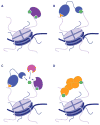Operating on chromatin, a colorful language where context matters
- PMID: 21272588
- PMCID: PMC3085666
- DOI: 10.1016/j.jmb.2011.01.040
Operating on chromatin, a colorful language where context matters
Abstract
Histones, the fundamental packaging elements of eukaryotic DNA, are highly decorated with a diverse set of post-translational modifications (PTMs) that are recognized to govern the structure and function of chromatin. Ten years ago, we put forward the histone code hypothesis, which provided a model to explain how single and/or combinatorial PTMs on histones regulate the diverse activities associated with chromatin (e.g., gene transcription). At that time, there was a limited understanding of both the number of PTMs that occur on histones and the proteins that place, remove, and interpret them. Since the conception of this hypothesis, the field has witnessed an unprecedented advance in our understanding of the enzymes that contribute to the establishment of histone PTMs, as well as the diverse effector proteins that bind them. While debate continues as to whether histone PTMs truly constitute a strict "code," it is becoming clear that PTMs on histone proteins function in elaborate combinations to regulate the many activities associated with chromatin. In this special issue, we celebrate the 50th anniversary of the landmark publication of the lac operon with a review that provides a current view of the histone code hypothesis, the lessons we have learned over the last decade, and the technologies that will drive our understanding of histone PTMs forward in the future.
Copyright © 2011 Elsevier Ltd. All rights reserved.
Figures


References
-
- Jacob F. Evolution and tinkering. Science. 1977;196:1161–6. - PubMed
-
- Jacob F, Monod J. Genetic regulatory mechanisms in the synthesis of proteins. J Mol Biol. 1961;3:318–56. - PubMed
-
- Jacob F, Perrin D, Sanchez C, Monod J. Operon: a group of genes with the expression coordinated by an operator. C R Hebd Seances Acad Sci. 1960;250:1727–9. - PubMed
-
- Struhl K. Fundamentally different logic of gene regulation in eukaryotes and prokaryotes. Cell. 1999;98:1–4. - PubMed
-
- Kornberg RD, Lorch Y. Twenty-five years of the nucleosome, fundamental particle of the eukaryote chromosome. Cell. 1999;98:285–94. - PubMed
Publication types
MeSH terms
Substances
Grants and funding
LinkOut - more resources
Full Text Sources
Other Literature Sources
Miscellaneous

